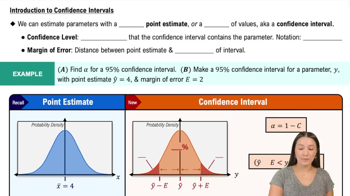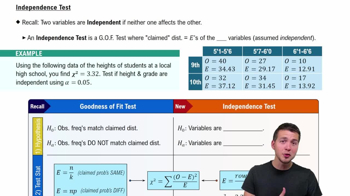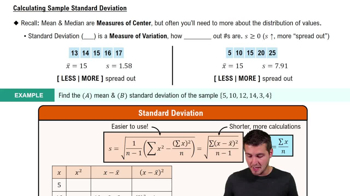Job Search A Gallup poll of 195,600 employees showed that 51% of them were actively searching for new jobs. Use a 0.01 significance level to test the claim that the majority of employees are searching for new jobs
Table of contents
- 1. Intro to Stats and Collecting Data1h 14m
- 2. Describing Data with Tables and Graphs1h 55m
- 3. Describing Data Numerically2h 5m
- 4. Probability2h 16m
- 5. Binomial Distribution & Discrete Random Variables3h 6m
- 6. Normal Distribution and Continuous Random Variables2h 11m
- 7. Sampling Distributions & Confidence Intervals: Mean3h 23m
- Sampling Distribution of the Sample Mean and Central Limit Theorem19m
- Distribution of Sample Mean - Excel23m
- Introduction to Confidence Intervals15m
- Confidence Intervals for Population Mean1h 18m
- Determining the Minimum Sample Size Required12m
- Finding Probabilities and T Critical Values - Excel28m
- Confidence Intervals for Population Means - Excel25m
- 8. Sampling Distributions & Confidence Intervals: Proportion1h 12m
- 9. Hypothesis Testing for One Sample3h 29m
- 10. Hypothesis Testing for Two Samples4h 50m
- Two Proportions1h 13m
- Two Proportions Hypothesis Test - Excel28m
- Two Means - Unknown, Unequal Variance1h 3m
- Two Means - Unknown Variances Hypothesis Test - Excel12m
- Two Means - Unknown, Equal Variance15m
- Two Means - Unknown, Equal Variances Hypothesis Test - Excel9m
- Two Means - Known Variance12m
- Two Means - Sigma Known Hypothesis Test - Excel21m
- Two Means - Matched Pairs (Dependent Samples)42m
- Matched Pairs Hypothesis Test - Excel12m
- 11. Correlation1h 6m
- 12. Regression1h 50m
- 13. Chi-Square Tests & Goodness of Fit1h 57m
- 14. ANOVA1h 57m
9. Hypothesis Testing for One Sample
Steps in Hypothesis Testing
Problem 9.2.6b
Textbook Question
In Exercises 5–20, assume that the two samples are independent simple random samples selected from normally distributed populations, and do not assume that the population standard deviations are equal. (Note: Answers in Appendix D include technology answers based on Formula 9-1 along with “Table” answers based on Table A-3 with df equal to the smaller of n1-1 and n2-1)
Readability of Font On a Computer Screen The statistics shown below were obtained from a standard test of readability of fonts on a computer screen (based on data from “Reading on the Computer Screen: Does Font Type Have Effects on Web Text Readability?” by Ali et al., International Education Studies, Vol. 6, No. 3). Reading speed and accuracy were combined into a readability performance score (x), where a higher score represents better font readability.
b. Construct the confidence interval suitable for testing the claim in part (a).

 Verified step by step guidance
Verified step by step guidance1
Step 1: Identify the given data for both samples. For the Roman font: sample size (n₁) = 24, sample mean (x̄₁) = 66.25, and sample standard deviation (s₁) = 12.96. For the Arial font: sample size (n₂) = 24, sample mean (x̄₂) = 65.62, and sample standard deviation (s₂) = 9.93.
Step 2: Use the formula for the confidence interval for the difference between two means when the population standard deviations are not assumed to be equal. The formula is: CI = (x̄₁ - x̄₂) ± t * √((s₁²/n₁) + (s₂²/n₂)), where t is the critical value from the t-distribution with degrees of freedom calculated using the Welch-Satterthwaite equation.
Step 3: Calculate the degrees of freedom (df) using the Welch-Satterthwaite equation: df = ((s₁²/n₁ + s₂²/n₂)²) / (((s₁²/n₁)² / (n₁ - 1)) + ((s₂²/n₂)² / (n₂ - 1))). Substitute the given values into this formula to find the approximate df.
Step 4: Determine the critical t-value (t) for the desired confidence level (e.g., 95%) using the calculated degrees of freedom and a t-distribution table or technology. Ensure you use a two-tailed test since the confidence interval is symmetric.
Step 5: Substitute the values of x̄₁, x̄₂, s₁, s₂, n₁, n₂, and t into the confidence interval formula to compute the lower and upper bounds of the confidence interval. This will give you the range of values for the difference in readability performance scores between the two fonts.
 Verified video answer for a similar problem:
Verified video answer for a similar problem:This video solution was recommended by our tutors as helpful for the problem above
Video duration:
6mPlay a video:
Was this helpful?
Key Concepts
Here are the essential concepts you must grasp in order to answer the question correctly.
Confidence Interval
A confidence interval is a range of values, derived from sample statistics, that is likely to contain the true population parameter. It is calculated using the sample mean, standard deviation, and a critical value from the t-distribution, especially when the sample size is small. The width of the interval reflects the level of uncertainty about the estimate, with wider intervals indicating more uncertainty.
Recommended video:

Introduction to Confidence Intervals
Independent Samples
Independent samples refer to two or more groups that are not related or paired in any way. In statistical analysis, this means that the selection of one sample does not influence the selection of another. This concept is crucial when comparing means from different groups, as it allows for the application of specific statistical tests, such as the independent t-test.
Recommended video:
Guided course

Independence Test
Standard Deviation
Standard deviation is a measure of the amount of variation or dispersion in a set of values. A low standard deviation indicates that the values tend to be close to the mean, while a high standard deviation indicates that the values are spread out over a wider range. In the context of the question, it helps assess the reliability of the readability performance scores for the different font types.
Recommended video:
Guided course

Calculating Standard Deviation

 6:21m
6:21mWatch next
Master Step 1: Write Hypotheses with a bite sized video explanation from Patrick
Start learningRelated Videos
Related Practice
Textbook Question
